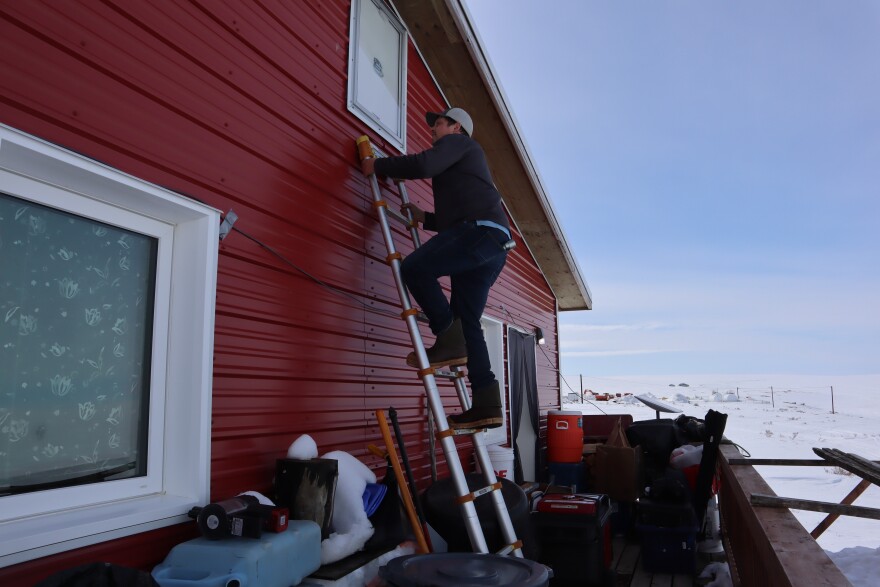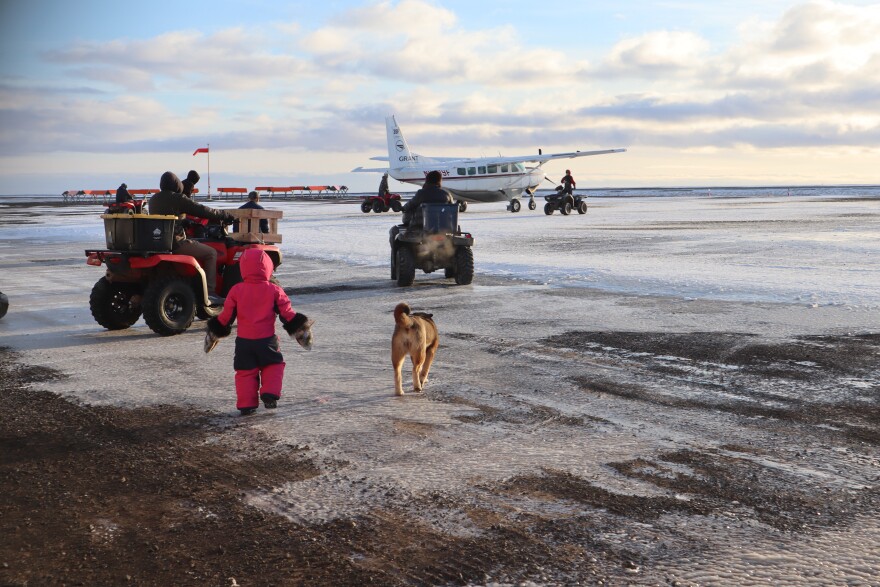There are lots of reasons why it’s taken four decades to move Newtok to the new village of Mertarvik. Piecemeal federal funding, inadequate planning from outside agencies, and internal political conflict within the tribal council are a few.
A lot of problems have followed people to the new community of Mertarvik. One of them is that there’s not enough permanent housing. And nearly half of the housing that does exist on the ground has serious problems.
In 2023, Francis Tom’s doors stopped closing properly and he noticed gaps forming between the walls, floor, and ceiling. Tom, a tribal council member, struggled to keep his modest, blue, two-bedroom house warm in the winter and he noticed water and condensation inside.

“I think these are like California houses,” said Tom. He said that he isn’t convinced his house is built for the high winds, driving rain and snow, and the generally wet conditions that exist in Mertarvik. Emmett Leffel, a Fairbanks-based building inspector and energy auditor, agreed.
“I've seen lots of construction across the state of Alaska,” Leffel said. “For this being new construction, absolutely, this is still some of the worst construction I’ve ever seen.”
Leffel has more than 15 years of experience in cold climate building design. In a report, he documented several instances of code violations and serious concerns about structural integrity and overall quality of some of Mertarvik’s brand new housing.
The United States Bureau of Indian Affairs (BIA) is the largest funder of this relocation.
“We've never really done anything like this before in this country, particularly for tribes,” said the BIA's former Assistant Secretary for Indian Affairs, Brian Newland, in November 2022.
In 2023, the BIA spent thousands of dollars to send half a dozen people from Newland’s office and other BIA staff to Mertarvik to tour new housing construction alongside Newtok Village Council members. The housing was paid for with funds from both the BIA and the U.S. Department of Housing and Urban Development (HUD).
Village council members said that everyone on the tour saw water damage inside some of the brand new houses. The light fixtures were filled with water, but no repairs have ever been made.
“There is no manual for relocation of communities anywhere,” said Alaska Native Tribal Health Consortium (ANTHC) Climate Initiatives Director Jackie Schaeffer. Her organization is among several that worked alongside state and federal agencies to support Newtok’s move for years.
Schaeffer was also on the 2023 tour. “Tribes say this is not the outcome we thought. We bring the federal agency in there. They look at it. What they do from that point on is out of our control,” she said.
ANTHC has been providing technical assistance to the tribe for this relocation.
“Getting those agencies into the homes is technical assistance. It's showing the funder what the outcome was. That is our job. But that nobody, there is no accountability and nobody has gone back to take responsibility for that,” Schaeffer said. “It's travesty, I don't know what else to call it.”
A BIA spokesperson said that staff have made three more visits to Mertarvik in the last two years, but would not say why. The Newtok Village Council’s attorney, Matt Mead, also said in an email that multiple homes were inspected by independent engineers this past year, but he would not provide those inspections. Two tribal council members have disputed Mead’s claim, including Tom, who said that no one other than Leffel had ever been inside his home to evaluate it.

At least a dozen other residents denied that anyone other than Leffel had ever been inside their homes to inspect them.
There are three different permanent housing projects in Mertarvik, in addition to some interim housing. In 2024, KYUK hired Leffel to inspect all three permanent designs because the village council and federal agencies couldn’t provide formal inspections.
Leffel measured air leakage and assessed homes for tightness, energy efficiency, and safety. He found serious problems with one of the designs – that of Anchorage-based LeMay Engineering and Consulting.
“This was very leaky, and the impact is so quickly realized and it's because of the coastal climate,” Leffel said.
KYUK sent Leffel’s report to the founder and owner of LeMay Engineering and Consulting, Patrick LeMay. LeMay didn’t respond to specific questions or multiple requests for comment other than to say in an email: “I do not work for Newtok any longer.”
KYUK also shared Leffel’s inspection report with the Newtok Village Council, its attorney, BIA, and HUD. They all declined to comment or answer specific questions about the condition of the housing or Leffel’s findings. On behalf of the tribe, attorney Matt Mead disputed that homes in Mertarvik were deteriorating.
Newtok’s relocation was supposed to provide a model for dozens of Alaskan communities that will need to move in the coming decades. But for experts, including Schaeffer, it’s become a cautionary tale instead.
“This is a forced location relocation by nature,” Schaeffer said. “It’s nature forcing you to relocate. So it's not voluntary. We have to understand that. Nobody gets to choose.”
Schaeffer said that while the condition of housing and infrastructure in Mertarvik is not the relocation outcome anyone had hoped for, it does still offer lessons for the future.
“You know, Newtok, it was a long process and patchwork of funding, and it did not flow well, and we are going to deal with unhealthy outcomes because of that,” Schaeffer said. “So how do we learn from that and better prepare decision making that is timed appropriately so that it doesn't have a stop and go process, it has a better flow?”
Whether it’s deteriorating permafrost, riverbank erosion, or land subsidence, the U.S. Army Corps of Engineers said that dozens of remote communities in Alaska are dealing with what Newtok has dealt with for four decades, but those villages don’t have another 40 years.

This reporting was supported by the Alaska Center for Excellence in Reporting.



